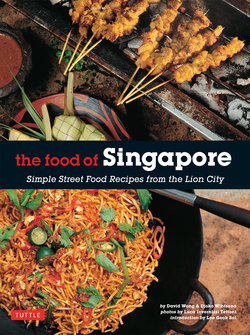Читать книгу Food of Singapore - David Wong - Страница 9
На сайте Литреса книга снята с продажи.
ОглавлениеEtiquette and Enjoyment
Whatever the ethnic community, and wherever the place, eating in Singapore is always communal. The assortment of dishes appear all at once, diners get individual servings of warm, fragrant rice and then help themselves to the side dishes. One exception to this is the Chinese banquet, a formal eight- or ten-course dinner, where the dishes appear one at a time.
"Don't use your fingers" is not an admonishment you will hear often. Indians, Malays and Straits Chinese will tell you that curry and rice taste best when you can literally feel the food with your fingers.
There are many interesting expressions and gestures that revolve around the dining table. Before the meal begins, it is considered polite to invite the more senior members at the table to eat. This harkens back to the Malay and Indonesian village tradition of inviting people present to partake in a meal. Members of the family often express their affection by dishing the choicest pieces into the bowls of their loved ones Singaporean hosts—especially the older generation Chinese—would shudder at the thought of their guests leaving their dining table with their stomachs still hungry, and would rather pile their tables high with insurmountable portions of food. Note however, that guests who do not at least finish what is on their plate—down to the last grain of rice—are considered rude, so be careful how much food you place in yours!
Eating with your hand has its own etiquette, too. Only the right hand is used and just the fingers; the palm has to be kept perfectly clean. Washing the hands before eating is not only polite but hygienic. In finer Indian and Malay restaurants, a waiter will bring a bowl of warm water, sometimes with a lime, before and after a meal in some Chinese restaurants, the bowl of delicately fragrant lime water is also a common sight whenever Chilli Crab or Prawns are served in the shell. There have been reports of unsuspecting tourists mistaking the water for a drink—so do warn your guests beforehand, especially if they are not familiar with Southeast Asian dining practices. In the more pedestrian curry shops or "banana leaf" restaurants, there will usually be a row of wash basins and soap for customers to clean up. Even with clean hands, diners should touch only the food on their plate, never that in the communal dishes, and the left hand is used to hold the serving spoon to keep it clean.
Chinese food is more likely to be eaten with chopsticks, although at some Chinese food stalls and in many Chinese homes, forks, spoons and knives are used. At a ten-course Chinese meal, chopsticks are de rigueur. Sucking or licking the tips of the chopsticks is considered impolite and contact between mouth and the tips of chopsticks is kept minimal Spoons are set out for larger mouthfuls. In between mouthfuls, never leave your chopsticks stack into the rice or food—this is associated with rice offered to religious idols and the dead. Always place the chopsticks together resting on a bowl or with the tips on your plate and the handles on the table.
Some ancient Chinese traditions live on in modern Singapore, where a teahouse offers a chance for repose while drinking a specially brewed pot of tea.
Often before and always at the end of the meal, hot towels are handed round for cleaning the face and hands. It is also common to receive individually wrapped rolls of perfumed, wet paper towels in many Chinese restaurants.
Chinese tea is the traditional drink with Chinese food— the hot, slightly bitter brew of oolong tea is a superb accompaniment to oily stir-fries. If you prefer something milder and sweeter, you can ask for a pot of chrysanthemum tea. Hot water for the pot is always refillable, but the first brew is always the thickest. For some, however, there is nothing quite like beer to take the heat off your tongue and to cool you down when you eat spicy food. One of the major local beers, Tiger, has won awards world-wide and has even been immortalized in Anthony Burgess' satirical novel, Time for a Tiger.
